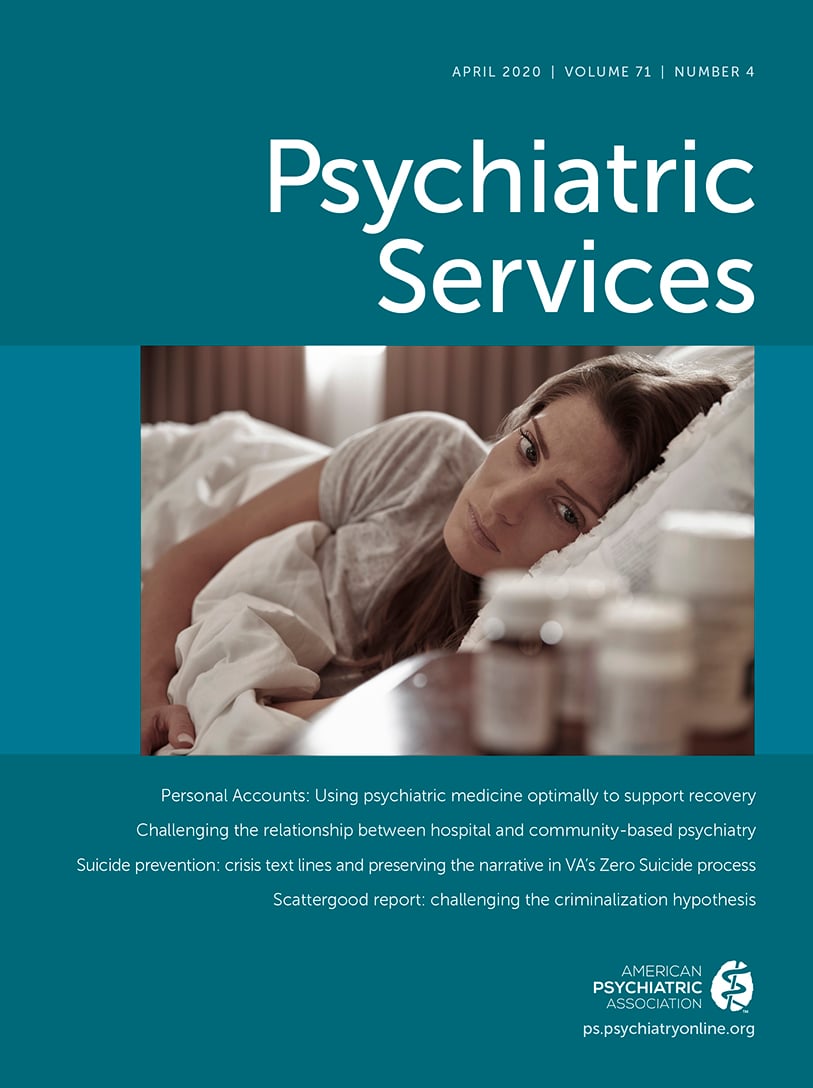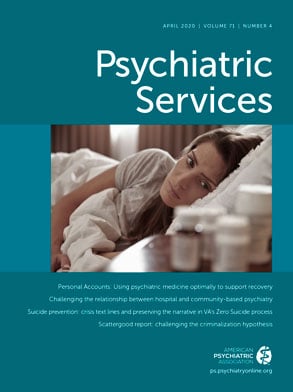Hoarding disorder, characterized by difficulty discarding possessions and accumulation of clutter, prevents normal use of the living space and causes distress. Hoarding disorder also causes significant public health consequences, including fire hazards, unsanitary living conditions, and structural damage, which may violate building, fire, or property maintenance codes and lead to eviction and homelessness. The prevalence of hoarding behaviors in one community eviction-prevention agency’s client population was four to 10 times higher than in the general population (22% versus 2%−6%, respectively) (
1). Evictions are a major cause of homelessness (
2,
3). A U.K. study evaluated the prevalence of hoarding disorder among 78 randomly selected homeless individuals newly admitted to Salvation Army shelters (Mataix-Cols et al., personal communication). A total of 21% of these individuals endorsed hoarding symptoms, and 8% reported that hoarding problems directly contributed to their homelessness.
Despite the impairment and negative repercussions caused by the clutter, individuals with hoarding disorder are often hesitant to seek treatment, possibly because of the stigma associated with the disorder (
4). Instead, these individuals often come to the attention of non–mental health agencies (e.g., fire department, police) during emergencies (e.g., pest infestation, fire, or eviction) (
1,
4,
5). If they do seek mental health treatment, it is often for the treatment of other disorders. Therefore, resources such as community eviction-prevention agencies represent an important way to identify individuals with hoarding disorder who may benefit from treatment and may not otherwise seek it.
To increase the likelihood for individuals with hoarding disorder to utilize community resources and prevent eviction, critical time intervention (CTI), an evidence-based model of case management, was adapted and pilot-tested with individuals with hoarding disorder who were concerned that they were at risk for eviction. CTI is a well-established cost-effective model of case management designed to help vulnerable individuals with mental illness through particularly difficult periods in their lives (
6). CTI was originally designed to prevent previously homeless men with severe mental illnesses from returning to homelessness during the transition from institutional living (hospital, shelter, etc.) to community living (community housing) (
6). The adaptation of CTI for individuals with hoarding disorder (CTI-HD) uses the duration of the threat of eviction, during which an individual receives an eviction notice or experiences concern about eviction, as the critical time period.
We hypothesized that CTI-HD would be an effective intervention for individuals with hoarding disorder who were at risk for eviction, and we enrolled 14 participants into the CTI-HD program. The feasibility of CTI-HD was assessed via three outcomes: rate of participant completion of the intervention at 9 months, usage of six services and resources offered, and change in hoarding severity as measured by the Saving Inventory–Revised (SI-R) and Clutter Image Rating Scale (CIR).
Critical Time Intervention for Hoarding Disorder
The model.
The guiding principles of CTI-HD include collaborative and flexible decision making, ongoing engagement, continued assessment, and a time-limited approach. The goal of CTI-HD is to provide support and resources during a critical risk period for eviction in order to prevent negative outcomes (e.g., eviction, homelessness) and promote positive outcomes (e.g., decrease in symptoms of hoarding disorder). Continuity of support is hypothesized to lead to better outcomes. For this study, case managers helped increase the number and strength of participants’ ties to community resources by developing rapport, gathering information about eviction risk, and providing support over a 9-month period.
In phase 1 of the CTI-HD program (first 3 months), the case managers used engagement strategies to establish rapport with each client and lay the foundation for the intervention through the following activities: assessing the client’s current eviction risk and risk status; assessing mental health needs with a full psychiatric evaluation and referral to providers for the management of comorbid conditions with medication as needed; referring clients to an evidence-based facilitated self-help support group called the Buried in Treasures (BIT) Workshop (
7), which entails receiving psychoeducation about hoarding disorder, developing ways to tolerate urges to acquire items, and building skills for parting with possessions; connecting the client to free legal counseling and entitlement registration clinics and accompanying the client to initial appointments; taking inventory of clients’ current and potential support networks and organizing family meetings; and engaging in frequent face-to-face meetings (at least one per week). Weekly home visits to assess the level of clutter and weekly phone check-ins to assess progress in decluttering were also available.
In phase 2 (4 months), case managers focused on reducing their involvement; conducted one check-in every 2 weeks; assessed the functioning of support networks, mental health resources, and other resources; and adjusted plans for delivery of services as necessary. Case managers also anticipated risk factors for relapse and worked with clients to enhance hope that anticipation and avoidance of risk factors could reduce the likelihood of relapse.
In phase 3 (2 months), case managers sought to optimize community support networks, conducted one check-in per month, and planned termination. Throughout all phases of the intervention, case managers tracked clients’ level of satisfaction, attendance at referred service appointments, and progress in decluttering.
Application.
Preparation of the pilot study included adapting the CTI manual for use with individuals with hoarding disorder who were at risk for eviction and consulting with CTI experts (D.H. and S.C.). Specifically, key elements of the adaptation included using the duration of the threat of eviction, during which an individual receives an eviction notice or experiences concern about eviction, as the critical period; offering evidence-based hoarding disorder treatment (e.g., BIT); and connecting clients to eviction-related services (e.g., legal services). Case managers were hired and trained in delivering the 9-month CTI model in three distinct phases, as detailed above. A local resource guide for referrals was created by building relationships with community providers and the director of an eviction-intervention service (A.T.).
Participants.
With approval from the New York State Psychiatric Institute Institutional Review Board, eligible adults with hoarding difficulties were recruited from January 2013 to July 2014 through flyers, social media advertisements, and referrals from housing authorities, a local nonprofit eviction-intervention service, and other external providers. All participants provided written informed consent. They were required to meet the DSM-5 criteria for hoarding disorder (as assessed by the Structured Interview for Hoarding Disorder) and to report concern about the threat of eviction due to clutter. Potential participants were excluded if they were severely depressed (Hamilton Depression Rating Scale score >30) or at risk of suicide (Columbia Suicide Severity Rating Scale score >4).
Procedures and assessments.
Potential participants were screened and completed an evaluation, including assessment via the SI-R and CIR, which were administered at baseline and at 3, 6, and 9 months to track changes in hoarding symptoms during the CTI-HD intervention. The SI-R is a 23-item self-report questionnaire that measures hoarding symptoms and has good test-retest reliability (κ=0.86). Possible scores range from 0 to 92, with higher scores indicating greater hoarding severity. The CIR is a three-item picture scale, which was administered by independent evaluators (S.V., A.S., E.J.) to assess level of clutter. The CIR has high internal consistency (alpha ranging from 0.77 to 0.91) and established test-retest reliability. Possible scores range from 1 to 9, with higher scores indicating more clutter.
Results
Of the 14 adults who enrolled, 11 participants (80%) completed the 9-month intervention. Most participants were female (N=10, 71%), and the sample had a mean±SD age of 60.6±8.0 years. Eight participants were Caucasian, five were African American, and one was Hispanic. Various participants met criteria for major depression (N=8), specific phobia (N=5), dysthymic disorder (N=3), panic disorder (N=3), binge eating disorder (N=2), mood disorder due to a general medical condition (N=1), and agoraphobia without panic disorder (N=1). Of the six CTI-HD treatments and services offered to the 14 participants, the following were utilized: facilitated self-help group therapy (N=14), legal counseling (N=9), decluttering assistance (N=9), psychiatric evaluation (N=7), coordination of family and support network (N=6), and entitlement registration (N=4).
Figure 1 shows the change in hoarding severity—a 25% decrease in mean SI-R score. Challenges included difficulty scheduling appointments, with four participants requesting rescheduling at least once.
Discussion and Conclusions
This pilot study was the first study to address the gap in treatment resources for individuals with hoarding disorder by providing a low-cost, flexible, and time-limited community-based program to improve quality of life and prevent eviction. The following findings indicate the feasibility of the intervention: a high rate of retention (N=11, 80%); 100% enrollment in the facilitated self-help group (BIT), the most utilized resource; and a 25% decrease in hoarding symptoms as measured by the SI-R. No participant was evicted.
The likelihood that participants completed the intervention was similar to that of a study that used a cognitive-behavioral therapy (CBT) group intervention for individuals with hoarding disorder, in which 67% of the sample (N=30) completed study procedures (
8). Two other studies assessed the retention of participants in group and individual therapy interventions for hoarding disorder. Frost et al. (
7) reported that 95% of the sample (41 out of 43 participants) completed a 13-week peer-led BIT group. Ayers et al. (
9) reported that 100% of the sample (N=12) completed 17 weeks of individual CBT for hoarding disorder.
The observed decreases in hoarding severity were comparable with more intensive and more costly treatments (
7). Over 9 months, hoarding symptom severity in this sample decreased by 25% as measured by the SI-R. In comparison, Gilliam et al. (
8) reported a 26% decrease in SI-R ratings for group CBT for hoarding disorder, Frost et al. (
7) found a 25% decrease in SI-R ratings for a BIT group therapy, and Ayers et al. (
9) reported a 21% decrease in SI-R ratings for individual CBT therapy for hoarding disorder. In our sample, the level of clutter, as assessed by the CIR, decreased (on average from 6 to 5), but the level of clutter was still severe enough to put clients at continued risk for eviction.
The leaders of CTI-HD met with the New York State Office of Mental Health as well as Supportive Housing Network of New York and informed officials about the CTI-HD program, system barriers they had identified, and lessons learned. Specifically, one lesson learned was that difficulty in communication and organization may reflect the inherent nature of hoarding disorder.
Given the intervention’s modest effects on clutter and continued risk for eviction for people with severe symptoms of hoarding disorder, a treatment that goes beyond CTI-HD is needed. Future studies should explore which interventions are most effective in addressing residual clutter as well as maximizing community stakeholder engagement (
10) and participant engagement in hoarding disorder treatment modalities.
Acknowledgments
The authors thank those who generously donated their time to participate in this study. The authors appreciate Dr. Lisa Dixon’s feedback on adapting the critical time intervention manual for use with individuals who have hoarding disorder and are at risk for eviction.


